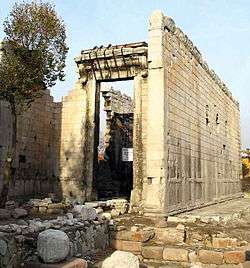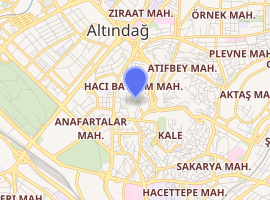Temple of Augustus and Rome
Temple of Augustus and Rome; is an augusteum located in Altındağ district of Ankara. It is thought to have been built around 25-20 AD. Besides being one of the most important Roman period ruins in the city, it is also known for Monumentum Ancyranum. This is an inscription about the works of Augustus, who was considered the first Roman emperor, throughout his life. It is the most complete copy of Res Gestae Divi Augusti that has survived to the present day, as the original in Rome had disappeared.[1]
| Temple of Augustus and Rome | |
|---|---|
Augustus Tapınağı | |
 | |

| |
| General information | |
| Type | Augusteum |
| Architectural style | Roman Architecture |
| Town or city | Ankara |
| Country | Turkey |
| Coordinates | 39°56′40″N 32°51′30″E |
| Technical details | |
| Material | Marble |
History
An earlier, 2nd century BCE Phrygian temple on the site was destroyed.[1]
The Augusteum was built between 25–20 BC after the conquest of central Anatolia by the Roman Empire and the formation of the Galatia province, with Ancyra as its administrative capital.
It was reintroduced to the western world by Ogier Ghiselin de Busbecq, ambassador of Ferdinand of Austria, to the Sultan Suleyman the Magnificent (1555–1562) at Amasia in Asia Minor. Busbecq first read the inscription and identified its origin from his reading of Suetonius; he published a copy of parts of it in his Turkish Letters.[2]
Only the side walls and the ornamented door frame remain; the positions of six columns can still be recognized.[1]
Monumentum Ancyranum
After the death of Augustus in AD 14, a copy of the text of the Res Gestae Divi Augusti was inscribed on both walls inside the pronaos in Latin, with a Greek translation on an exterior wall of the cella.
The inscriptions are the primary surviving source of the text, since the original inscription on bronze pillars in front of the Mausoleum of Augustus in Rome has long been lost, and two other surviving inscriptions of the text are incomplete.[3] Squeezes of the Monumentum Ancyrum were obtained by the Cornell Expedition in 1907–1908, and have been the basis for epigraphic study including by the epigrapher Mariana McCaulley.[4][5][6]
Copies
A life-size reproduction of the pronaos, including the text of the Deeds, was erected in the gardens of the Baths of Diocletian in Rome for the Archaeological Exhibition of the 1911 Rome World's Fair. After the fair, it was put in storage until it was displayed at the Mostra Augustea della Romanità in 1937.[7] After WWII, it was moved to Room IX of the new Museo della Civiltà Romana.[8]
See also
References
- Ahmet Gökdemir, Can Demirel, Yavuz Yeğin, Zeynel Şimşek, "Ankara Temple (Monumentum Ancyranum/Temple of Augustus and Rome) restoration", Case Studies in Construction Materials 2:55-65 (June 2015) doi:10.1016/j.cscm.2015.02.002 full text
- Edward Seymour Forster, translator, The Turkish Letters of Ogier de Busbecq reprinted Louisiana State University 2005.
- Diehl, editor of Res Gestae Divi Augusti in the Loeb Classical Library remarks that at the time the original document was copied on the walls of many of the temples of Augustus throughout the empire, but the inscriptions have not survived.
- "Res Gestae Divi Augusti | Cornell Collections of Antiquities". antiquities.library.cornell.edu. Retrieved 2019-01-10.
- McCaulley, Mariana (1912). A collation of the Cornell squeeze of the Monumentum Ancyranum and a translation of the inscription (A. M. thesis). Cornell University.
- "Cornell Expedition | Cornell Collections of Antiquities". antiquities.library.cornell.edu. Retrieved 2019-01-10.
- Joshua Arthurs, Excavating Modernity: The Roman Past in Fascist Italy, ISBN 0801449987, 2012, p. 95-111
- "Room IX: Augustus", Museo della Civiltà Romana
Further reading
- Botteri, P.; Fangi, G. (2003). "The Ancyra Project: the Temple of Augustus and Rome". Ankara, ISPRS Archives. volume XXXIV. pp. 84–88. part 5/W12 Commission V.
- Chisholm, Hugh, ed. (1911), , Encyclopædia Britannica, 1 (11th ed.), Cambridge University Press, p. 953CS1 maint: ref=harv (link)